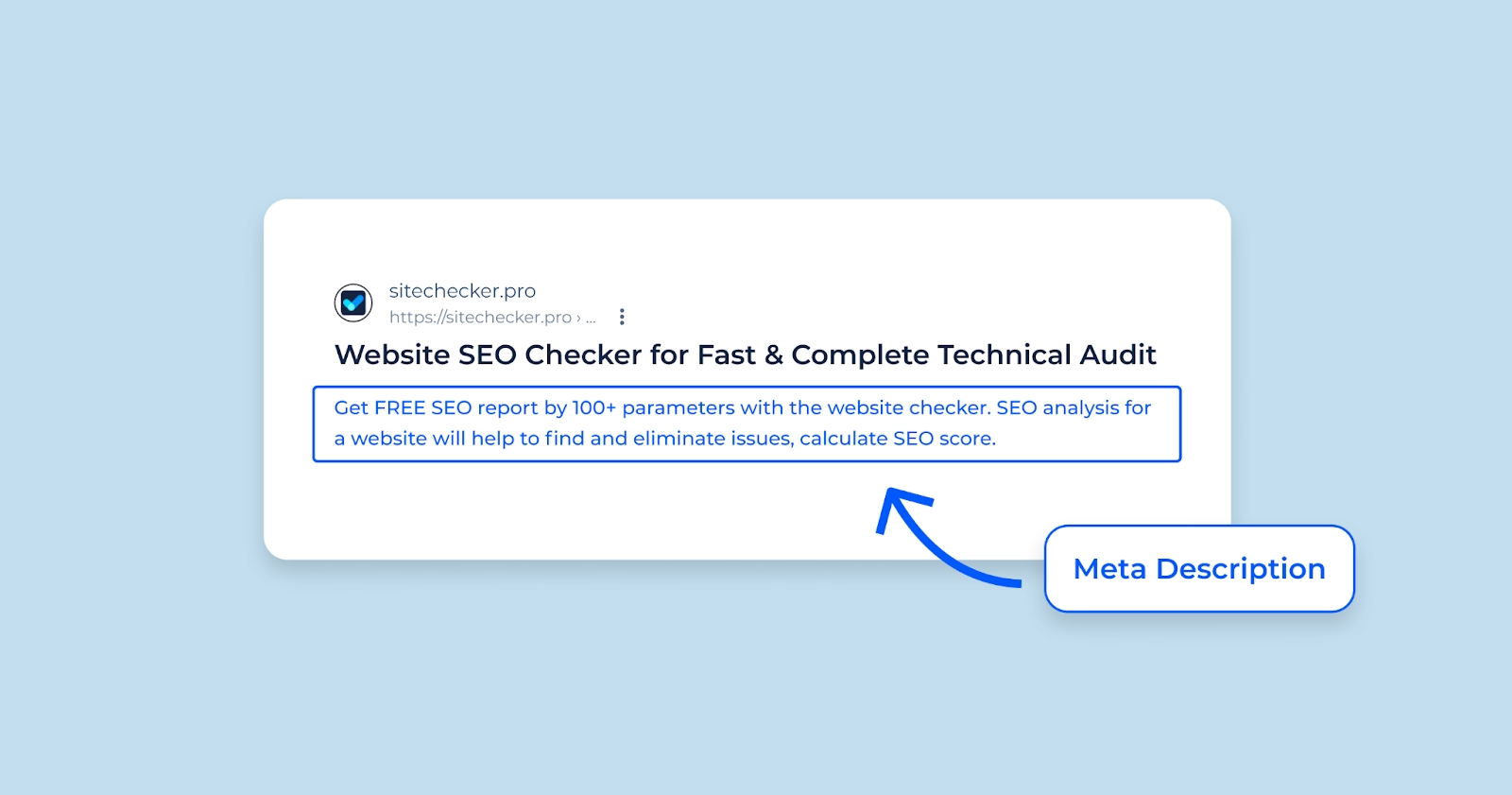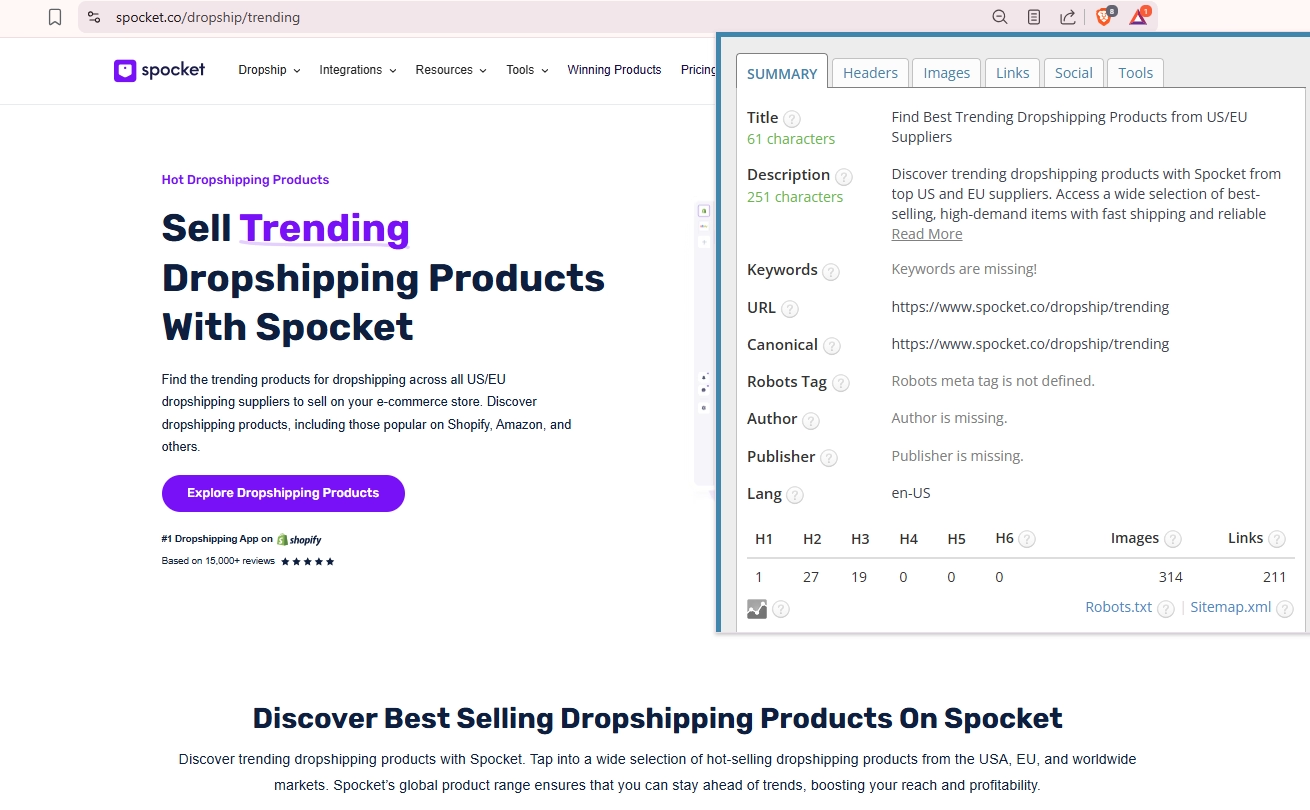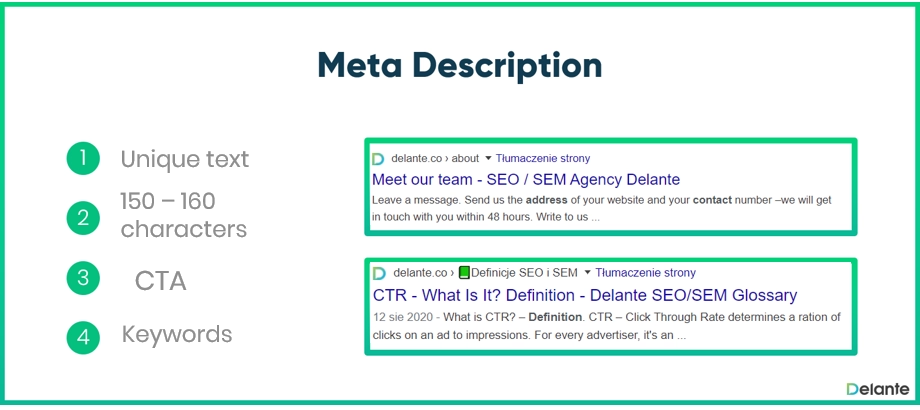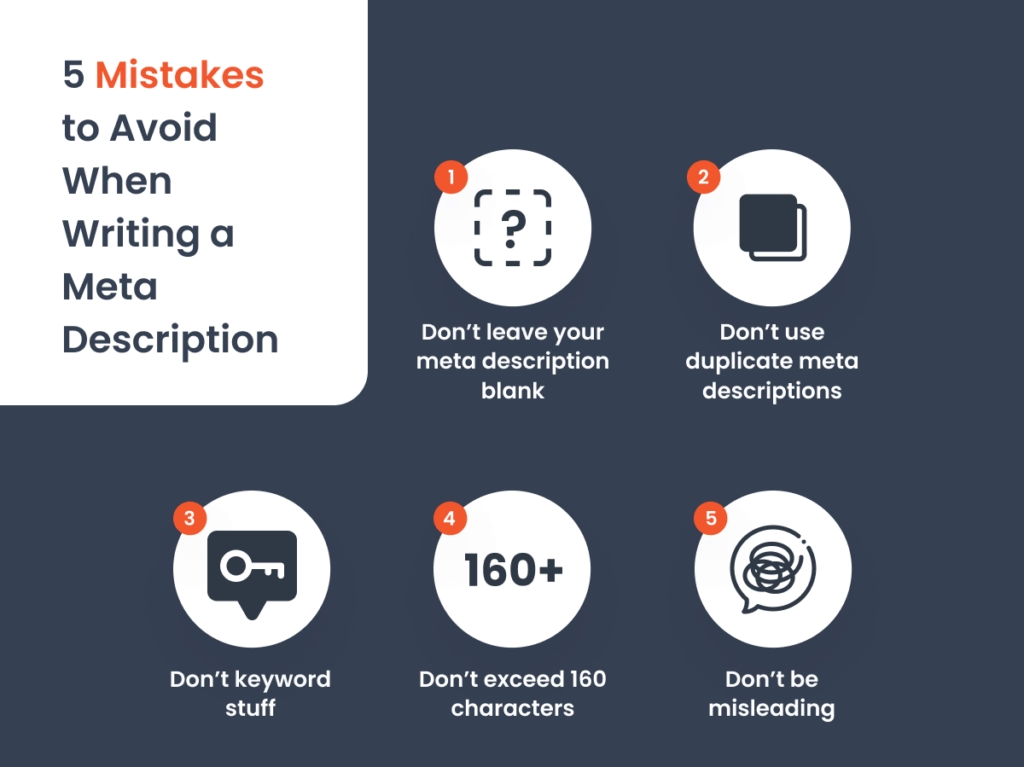Meta descriptions play a crucial role in SEO by influencing how your website appears on search engine results pages (SERPs). These short snippets, often no longer than 160 characters, can make or break a user's decision to click on your link. So, how do you craft the perfect meta description? In this guide, we’ll show you how to write meta descriptions that not only improve your rankings but also increase your click-through rate (CTR). With actionable tips, meta description examples, and the latest insights, you’ll learn how to make your descriptions both engaging and SEO-optimized. Ready to boost your traffic and attract more visitors? Let’s dive in!

What is a Meta Description?
Meta descriptions are the small but mighty snippets you see under page titles in Google search results, on social media previews, and sometimes even in your browser tabs. If you want to write meta descriptions that actually work, you need to understand their role and how they connect users to your content. Think of them as your elevator pitch—they help searchers decide if your page is worth a click.

Let’s break down what makes a meta description essential and how you can use it to attract more visitors, boost your click-through rate, and make your content stand out.

Definition and Purpose
A meta description is a brief summary of a webpage’s content. You add it as an HTML tag in your site’s code. Its main job is to tell both users and search engines what your page is about in a clear, compelling way. When you write meta descriptions that are unique, relevant, and packed with your main keywords, you help search engines understand your page and encourage users to click through to your site.
Meta descriptions don’t directly impact your rankings, but they do influence how many people click on your link. According to Google, a well-written meta description can significantly increase your click-through rate (CTR), which can indirectly affect your SEO performance. In fact, pages with optimized meta descriptions see up to a 5.8% higher CTR compared to those without. That’s a simple tweak for a big impact!
Where Meta Descriptions Appear (SERPs, Social Media, Browsers)
You’ll spot meta descriptions in several key places:
- Search Engine Results Pages (SERPs): This is where they shine the most. When someone searches for a keyword, your meta description appears right below your page title. It acts as a preview, giving users a reason to click your link over others.
- Social Media Previews: When people share your page on platforms like Facebook or Twitter, the meta description often shows up as the summary. This helps make your content more clickable and shareable.
- Browser Tabs and Bookmarks: Some browsers use the meta description as a tooltip or preview, giving users a quick snapshot of your page.
If you want your content to get noticed, you need to write meta descriptions that are clear, concise, and tailored for these spots. Use meta description tools or a meta description checker to see how your snippet will look before you publish.
Meta Description in HTML: The Basics
Adding a meta description to your page is simple. You just need to insert a line of code in the <head> section of your HTML. Here’s how it looks:
<meta name="description" content="Learn how to write meta descriptions that boost SEO, attract clicks, and improve your website’s visibility with actionable tips and examples.">
This tag tells search engines what summary to display. Remember, Google may sometimes rewrite your meta description if it thinks another snippet from your page is more relevant to the user’s search.
Tips for Writing Meta Descriptions in HTML
- Keep it under 155 characters to avoid truncation on most devices.
- Use your primary keyword and related LSI keywords naturally.
- Make each description unique for every page—don’t copy and paste!
- Include a call to action, like "Learn more" or "Get started now," to encourage clicks.
If you want to see your meta description in action, right-click on any web page, select “View Page Source,” and look for the <meta name="description">.
What Should You Include in Your Meta Description?
A good meta description isn’t just about summarizing your content it’s about enticing users to click.

Here are the key elements you should include:
- Primary Keyword: Your target keyword should naturally fit into the description. This helps search engines match your content with user queries and draws attention by highlighting the keyword in bold.
- Value Proposition: Explain why users should click on your link. What makes your content or offering unique? Highlight the benefits or solutions your page provides.
- Call to Action (CTA): Use action-oriented language to encourage clicks. Phrases like “Discover,” “Learn,” or “Get started” often work well.
- Tone and Clarity: Match the tone of your description to your audience while keeping the language clear and concise. Avoid jargon unless it’s specific to your niche.
- Alignment with Content: Ensure your description reflects the actual content on the page. Misleading descriptions may get clicks but can harm your bounce rate and credibility.
Why Meta Descriptions Are Important for SEO
Meta descriptions are more than just a line of text under your page title. They act as your website’s first impression in search results. If you want to write meta descriptions that drive real results, you need to know why they matter for SEO, how they impact your traffic, and what Google does with them. Let’s break it down so you get a complete answer.
Impact on Click-Through Rate (CTR)
A well-crafted meta description can make your link irresistible in search results. Think of it as your “organic ad text.” When you write a meta description that’s clear, action-oriented, and fits the user’s search intent, you increase your chances of getting that click. Recent data shows that optimized meta tags can boost user engagement by about 30%. Descriptions between 150-160 characters see the highest CTR, and action words like “Discover” or “Learn” can lift engagement by up to 20%. Companies who focus on structured, unique meta descriptions report CTR jumps of 17-24% in just two months. That’s a big deal for your traffic.
Role in Search Engine Rankings
Meta descriptions don’t directly affect your position on Google. Google says they don’t use meta descriptions as a ranking factor. But here’s the catch: if your meta description gets more people to click, Google notices. Higher CTR signals to Google that your page is a good match for the query. Over time, this can help your page move up in the rankings. So, while you won’t rank higher just by stuffing keywords, you will benefit if your description attracts more clicks than your competitors.
How Google Uses and Sometimes Rewrites Meta Descriptions
Google doesn’t always show the meta description you write. Its algorithm scans your page and the search query, and sometimes it pulls a snippet from your content if it thinks it’s more relevant. This usually happens if your meta description is too long, off-topic, or duplicated across pages. To keep control, always write a meta description that matches your page content, uses relevant keywords, and stays within the recommended length (usually 155-160 characters).
If you want to stop Google from rewriting your snippet, you can use the “data-nosnippet” attribute in your HTML. But even when Google rewrites, your original meta description helps it understand your page and can still show up for many queries.
Why Unique Meta Descriptions Matter
Unique meta descriptions give your site a competitive edge. When every page has its own description, you avoid duplicate content issues and help users know exactly what to expect. Unique snippets improve engagement by up to 25% compared to duplicates. They also make your site look more professional and trustworthy, which can boost your brand’s authority and encourage repeat visits. If you use a meta description generator, always tweak the result to make it specific to your page.
Meta Description Length and Formatting Guidelines
Meta descriptions are your page’s invitation to users on Google. If you want to write meta descriptions that get clicks, you need to pay close attention to length and formatting. Let’s cover what works in 2025 and how you can make every character count.
Optimal Character Count for Meta Descriptions
Aim for 150–160 characters for your meta description. This range is the sweet spot—long enough to explain your page but short enough to avoid getting cut off. Google typically displays up to 158 characters, or about 920 pixels, on desktop. On mobile, you get a bit less—around 120 characters or 680 pixels. If you go over, Google may trim your description and add an ellipsis, which can weaken your message.
Most SEO experts and tools, like meta description checkers, recommend keeping your descriptions within this limit. In fact, recent updates from Google and platforms like Sitecore now block descriptions longer than 150 characters to prevent truncation. So, keep it concise and front-load the most important information.
How Meta Descriptions Are Truncated on Different Devices
Google uses pixels, not just character count, to decide where to cut off your meta description. On desktop, you have up to 920 pixels, which is about 158 characters. On mobile, it drops to 680 pixels, or roughly 120 characters. If your description goes over, Google truncates it to the nearest word and adds “...”. That’s why you want to place your main keywords and call to action near the beginning.
Device differences matter. What looks perfect on desktop might get chopped on mobile. To avoid this, focus on the first 120 characters for your core message. Use meta description tools to preview how your snippet appears on both devices before you publish.
Formatting Meta Descriptions in HTML
Adding a meta description is easy. Just place this tag in your page’s <head> section:
<meta name="description" content="Write meta descriptions that boost SEO and attract clicks. Keep it under 160 characters for best results.">
This snippet tells search engines what to show in search results. Always use your primary keyword and related LSI keywords naturally. Don’t stuff keywords—Google bolds terms that match the user’s search, making your listing stand out. Use a clear call to action and make each meta description unique for every page.
If you use a CMS like WordPress, tools like Yoast or All in One SEO make this process even easier. Just paste your description into the designated field, and the plugin handles the HTML for you.
Best Practices for Writing Effective Meta Descriptions
If you want to write meta descriptions that actually get clicks and boost your SEO, you need to follow a few essential best practices. Meta descriptions are your chance to make a strong first impression in search results, so every word matters. Let’s break down what works in 2025 and how you can make your meta descriptions stand out from the crowd.
Understand and Match Search Intent
Always start by thinking about what your audience wants. When you write a meta description, ask yourself: what problem does the searcher want to solve? Use language that matches their intent. If someone searches for “how to write meta descriptions examples,” give them a clear hint that your page has actionable tips or templates. Google rewards content that aligns with user intent, so this step is key for both engagement and SEO.
Use Primary and LSI Keywords Naturally
Place your main keyword, like “dropshipping products,” near the start of your snippet. Sprinkle in LSI keywords—those related phrases people also search for, such as “trending dropshipping products” or “winning dropshipping products.” This helps Google highlight your description and makes it more relevant to users. Don’t force keywords; keep the flow natural and conversational.
Include a Clear Call to Action
Tell users what you want them to do next. Phrases like “Learn more,” “Get started,” or “Discover top tips” encourage clicks. A strong call to action can boost your click-through rate by up to 20% in competitive niches. Make your invitation clear and direct—this is your chance to win that click.
Make Each Description Unique and Relevant
Every page deserves its own unique meta description. Avoid copying and pasting across your site. Tailor each snippet to the specific content of the page, whether it’s a blog post, product page, or category listing. Unique descriptions help users find exactly what they need and show Google that your content is high quality.
Keep It Concise, Engaging, and Informative
Stick to 140–160 characters for your meta description. This ensures your message isn’t cut off in search results. Use active, engaging language. Share the main benefit or value your page offers. According to recent data, concise meta descriptions see up to 30% higher CTR than longer, rambling ones.
Maintain Brand Voice and Value Proposition
Let your brand personality shine through. Whether you’re friendly, professional, or quirky, keep your tone consistent. Highlight what makes your site or offer unique. For example, if your brand is all about simplicity, say so in your description. This builds trust and helps users remember you.
Avoid Keyword Stuffing and Duplicate Content
Don’t overload your meta description with keywords. Google can spot keyword stuffing and may ignore your snippet or even penalize your site. Focus on clarity and usefulness instead. Also, avoid duplicate descriptions across multiple pages—this confuses both users and search engines.
Meta Description Examples for Different Page Types
If you want to write meta descriptions that truly connect with your audience, you need to tailor each one for the specific type of page. Every page—whether it’s your homepage, a blog post, a product, or a category—serves a different purpose. Let’s look at how you can craft the perfect meta description for each, using proven examples and best practices. This way, you have a one-stop solution for every scenario.
Homepage Meta Description Example
Your homepage meta description acts as your digital welcome mat. It should quickly explain what your site offers and why people should stay. For example:
“SiteSaga is a free online resource to help you make a successful website. It offers easy guides to create sites, grow traffic, and earn money.”
This description is clear, concise, and packed with benefits. It uses keywords like “free resource,” “successful website,” and “grow traffic,” which help with SEO. Always focus on what makes your site unique and how you help your visitors.
Blog Post Meta Description Example
For blog posts, your meta description should hook readers and promise value. Highlight what makes your post stand out. Here’s a strong example:
“Discover expert tips on how to write meta descriptions that boost your SEO and increase clicks. Learn actionable strategies in just five minutes.”
This snippet uses active language, includes the primary keyword, and tells the reader exactly what to expect. It’s short, direct, and encourages action.
Product Page Meta Description Example
Product pages need to sell benefits and build trust. Focus on what makes your product special and why someone should buy it. For example:
“Self-sharpening mechanical pencil that autocorrects your penmanship. Includes 2B auto-replenishing lead. Available in Vintage Pink and Schoolbus Yellow. Order 50+ pencils, get free shipping.”
This description is specific, highlights features, and includes a call to action. It also uses keywords like “auto-replenishing lead” and “free shipping,” which appeal to both users and search engines.
Category Page Meta Description Example
Category pages group similar products or content. Your meta description should highlight the variety and encourage browsing. Here’s a good example:
“Shop online for women’s shoes and enjoy a large selection and free shipping. Explore exclusive styles, top brands, and special offers for every occasion.”
This snippet uses phrases like “large selection,” “exclusive styles,” and “special offers” to draw shoppers in. It’s engaging, keyword-rich, and action-oriented.
Social Media Meta Description Example
Social media meta descriptions need to be catchy and shareable. They often double as your preview text, so keep them friendly and inviting:
“Get everything you need to sew your next garment. Open Monday–Friday 8-5pm, located in the Fashion District. Visit us for exclusive deals and expert advice.”
This example is concise, informative, and highlights what makes the business unique. It’s perfect for sharing and grabs attention in crowded feeds.
Common Meta Description Mistakes to Avoid
If you want to write meta descriptions that actually work, you need to steer clear of the most common mistakes. These errors can hurt your SEO, lower your click-through rates, and make your content look less professional. Let’s break down what you should avoid and why it matters.

Overusing Keywords
Stuffing your meta description with keywords might seem like a smart move, but it actually backfires. Google and other search engines see this as spammy and may ignore your description altogether. It also makes your snippet hard to read, which turns users away. Instead, use your main keyword naturally and focus on making your message clear and helpful.
Using Duplicate Descriptions
Copying the same meta description across multiple pages confuses both users and search engines. Google wants every page to have a unique description that matches its content. Duplicate meta descriptions dilute your SEO power and can cause your pages to rank lower. Make sure each page has its own, relevant summary.
Ignoring Search Intent
If your meta description doesn’t match what the user is searching for, you lose their interest fast. Always think about the search intent behind the keywords. For example, someone searching “how to write meta descriptions examples” wants tips and templates, not just a definition. Align your description with what users hope to find and you’ll see better engagement.
Writing Vague or Unclear Descriptions
A vague meta description doesn’t help anyone. If users can’t tell what your page is about, they’ll skip your link. Worse, if your description is misleading, users will bounce quickly, and Google tracks that. Make your descriptions specific and accurate, so readers know exactly what to expect.
Exceeding Optimal Length
Long meta descriptions get cut off in search results, which means users miss your main message. Google typically shows up to 160 characters. If you go over, your snippet ends with an ellipsis, and important details disappear. Keep your meta description concise and put the most valuable info up front.
Tools and Resources for Meta Descriptions
If you want to write meta descriptions that stand out, you don’t have to do it all by hand. There are plenty of smart tools and resources that make the process faster, easier, and more effective. Whether you need inspiration, optimization, or performance tracking, these solutions help you cover every step—so you get more clicks and better SEO results.
Meta Description Generators
Meta description generators use AI to craft keyword-rich, relevant snippets in seconds. Tools like Grammarly’s free AI Meta Description Generator, Ahrefs, Copy.ai, and Writesonic let you enter your keywords and page details, then instantly get several SEO-friendly options. Many of these tools, such as Team-GPT, Scalenut, and Frase, even let you choose your tone, language, and length, so your meta description matches your brand and audience. These generators save time and help you avoid writer’s block, especially when you need to create meta descriptions in bulk.
Meta Description Checkers
A meta description checker helps you see if your snippet meets Google’s best practices. These tools analyze your description for length, keyword usage, and clarity. They alert you if your meta description is too long, too short, or missing important keywords. Some, like AIOSEO and SearchAtlas, even preview how your snippet will look on desktop and mobile, so you know exactly what users will see before you publish. This step is crucial for avoiding truncation and making sure your meta descriptions are always optimized.
SEO Plugins and Extensions
If you use WordPress or other CMS platforms, SEO plugins like AIOSEO, Yoast, and Rank Math make it easy to write meta descriptions right inside your dashboard. These plugins offer real-time suggestions, keyword analysis, and even AI-generated options. They also help you manage meta descriptions for every page, post, and product—so you never miss an optimization opportunity. Extensions for Chrome and Firefox, like MozBar and SEOquake, let you audit meta descriptions on any site and compare with competitors.
Analytics for Performance Tracking
After you write meta descriptions, you need to know if they’re working. Google Search Console shows you which pages get the most clicks from search results, so you can see the direct impact of your meta descriptions. Tools like Ahrefs, SEMrush, and GrowthBar go deeper, letting you track click-through rates, rankings, and even A/B test different meta descriptions. This data helps you refine your approach and focus on what drives real results.
Conclusion: Mastering Meta Descriptions for Better SEO
Mastering meta descriptions is key to enhancing your SEO and boosting click-through rates. By crafting clear, concise, and action-oriented descriptions that match search intent, you can attract more visitors and improve your rankings. Always focus on using relevant keywords, keeping descriptions unique for each page, and staying within the ideal character limit. With the right tools and a strategic approach, you'll ensure your meta descriptions work for you, driving better engagement and achieving real results in your SEO efforts. Keep refining and optimizing to stay ahead in 2025 and beyond.







































